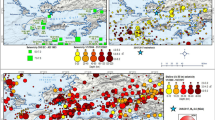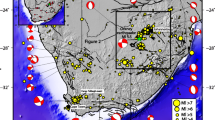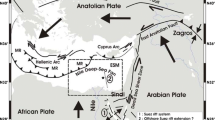Abstract
The 2015 Mw6.5 Lefkada main shock occurred at the south western part of Lefkada Island (Greece), less than 2 years after the occurrence of a doublet along the western part of the nearby Kefalonia Island, Paliki peninsula (on 25/01/2014, with Mw6.1 and 03/02/2014 with Mw6.0) and 12 years after the 2003 Mw6.2 main shock that struck the northwestern part of Lefkada Island. The four failed dextral strike slip fault segments belong to the Kefalonia transform fault zone (KTFZ), the major active boundary that bounds from the west the area of central Ionian Islands, namely Lefkada and Kefalonia. It is associated with several known historical earthquakes and is considered the most hazardous area in the Greek territory. The KTFZ fault segments are characterized by high slip rates (of the order of tens of millimeters per year), with maximum earthquake magnitudes up to 6.7 for Lefkada and 7.2 for Kefalonia fault zone, respectively. The double difference location technique was employed for relocating the aftershocks revealing a seismogenic layer extending from 3 to 16 km depth and multiple activation on well-defined fault planes, with strikes that differ than the main rupture and dips either to east or to west. This implies that strain energy was not solely released on a main fault only, but on secondary and adjacent fault segments as well. The reliable definition of their geometry forms the basis for the structural interpretation of the local fault network. The aftershock spatial distribution indicates three main clusters of the seismic activity, along with activation of smaller faults to an extent of more than 50 km. A northeasterly striking cluster is observed to the north of the main shock epicenter, with a remarkable aftershock density. The central cluster is less dense than the previous one with an epicentral alignment in full accordance with the strike provided by the main shock centroid moment tensor solution, and is considered as the main rupture with a length of 17 km. The third cluster, encompassing a large number of aftershocks, is located in the offshore area between Lefkada and Kefalonia Islands with a NE–SW epicentral alignment, alike the first cluster. The northeast–southwest striking secondary faults positioned obliquely and in continuation of the main fault segment, reveal that the KTFZ is being deformed in a complex tectonic setting. The presence of faults with this geometry implies strain partitioning and sheds light to new components necessary to be taken into account in the seismic hazard assessment. Stress transfer models of the M ≥6.0 main shocks were investigated and the calculated static stress changes may well explain their sequential occurrence. Static stress changes due to the 2015 coseismic slip were also calculated with the main objective of exploring the aftershock occurrence pattern and it was found as the driving mechanism that triggered the vast majority of the off-fault aftershocks.















Similar content being viewed by others
References
Becker, D., Meier, T., Rische, M., Bohnhoff, M., & Harjes, H.-P. (2006). Spatio–temporal microseismicity clustering in the Cretan region. Tectonophysics, 423, 3–16. doi:10.1016/j.tecto.2006.03.022.
Beeler, N. M., Simpson, R. W., Hickman, S. H., & Lockner, D. A. (2000). Pore fluid pressure, apparent friction and Coulomb failure. Journal of Geophysical Research, 105, 25533–25542.
Choussianitis, K., Ozgun Konca, A., Tselentis, G.-A., Papadopoulos, G., & Gianniou, M. (2016). Slip model of the 17 November 2015 Mw = 6.5 Lefkada earthquake from the joint inversion of geodetic and seismic data. Geophysical Research Letters. doi:10.1002/2016GL069764.
Deng, J., & Sykes, L. (1997). Evolution of the stress field in Southern California and triggering of moderate size earthquakes: a 200-year perspective. Journal of Geophysical Research, 102, 9859–9886.
Domínguez Cerdeña, I., del Fresno, C., & Gomis Moreno, A. (2014). Seismicity patterns prior to the 2011 El Hierro eruption. Bulletin of the Seismological Society of America, 104, 567–575. doi:10.1785/0120130200.
Efron, B. (1982). The jackknife, the bootstrap and other resampling plans. Philadelphia: SIAM. doi:10.1137/1.9781611970319.
Erickson, L. (1986). User’s manual for DIS3D: a three-dimensional dislocation program with applications to faulting in the Earth. Master’s Thesis, Stanford: Stanford University. p. 167.
Ganas, A., Elias, P., Bozionelos, G., Papathanassiou, G., Avallone, A., Papastergios, A., et al. (2016). Coseismic deformation, filed observations and seismic fault of the 17 November 2015 M w6.5, Lefkada Island, Greece earthquake. Tectonophysics, 687, 210–222.
Gomberg, J., Bodin, P., & Reasenberg, P. A. (2003). Observing earthquakes triggered in the near field by dynamic deformations. Bulletin of the Seismological Society of America, 93, 118–138.
Got, J.-L., Fréchet, J., & Klein, F. W. (1994). Deep fault plane geometry inferred from multiplet relative relocation beneath the south flank of Kilauea. Journal of Geophysical Research, 99, 15375–15386. doi:10.1029/94JB00577.
Harris, R. A. (1998). Introduction to special section: stress triggers, stress shadows, and implications for seismic hazard. Journal of Geophysical Research, 103, 24347–24358.
Haslinger, F., Kissling, E., Ansorge, J., Hatzfeld, D., Papadimitriou, E., Karakostas, V., et al. (1999). 3D crustal structure from local earthquake tomography around the gulf of Arta (Ionian region, NW Greece). Tectonophysics, 304, 201–218.
Hatzfeld, D., Kassaras, I., Panagiotopoulos, D., Amorese, D., Makropoulos, K., Karakaisis, G., et al. (1995). Microseismicity and strain pattern in northwestern Greece. Tectonics, 14, 773–785.
Ilieva, M., Briole, P., Ganas, A., Dimitrov, D., Elias, P., Mouratidis, A., et al. (2016). Fault plane modeling of the 2003 August 14 Lefkada Island (Greece) earthquake based on the analysis of ENVISAT SAR interferograms. Tectonophysics, 693, 47–65. doi:10.1016/j.tecto.2016.10.021.
Kagan, Y. Y. (1991). 3-D rotation of double-couple earthquake sources. Geophysical Journal International, 106, 709–716. doi:10.1111/j.1365-246X.1991.tb06343.x.
Karakostas, V. G., & Papadimitriou, E. E. (2010). Fault complexity associated with the 14 August 2003 Mw6.2 Lefkada, Greece, aftershock sequence. Acta Geophysica, 58, 838–854. doi:10.2478/s11600-010-0009-6.
Karakostas, V. G., Papadimitriou, E. E., & Gospodinov, D. (2014). Modeling the 2013 North Aegean (Greece) seismic sequence: geometrical and frictional constraints, and aftershock probabilities. Geophysical Journal International, 197, 525–541. doi:10.1093/gji/ggt523.
Karakostas, V. G., Papadimitriou, E. E., Karakaisis, G. F., Papazachos, C. B., Scordilis, E. M., Vargemezis, G., et al. (2003). The 2001 Skyros, northern Aegean, Greece, earthquake sequence: off-fault aftershocks, tectonic implications, and seismicity triggering. Geophysical Research Letters, 30(1), 1012. doi:10.1029/2002GL015814.
Karakostas, V., Papadimitriou, E., Mesimeri, M., Gkarlaouni, Ch., & Paradisopoulou, P. (2015). The 2014 Kefalonia doublet (Mw6.1 and Mw6.0) central Ionian Islands, Greece: seismotectonic implications along the Kefalonia transform fault zone. Acta Geophysica, 63, 1–16. doi:10.2478/s11600-014-0227-4.
Karakostas, V. G., Papadimitriou, E. E., & Papazachos, C. B. (2004). Properties of the 2003 Lefkada, Ionian Islands, Greece, earthquake seismic sequence and seismicity triggering. Bulletin of the Seismological Society of America, 94, 1976–1981.
Kikuchi, M., & Kanamori, H. (1991). Inversion of complex body waves–III. Bulletin of the Seismological Society of America, 81, 2335–2350.
Kiratzi, A. A., & Langston, C. (1991). Moment tensor inversion of the January 17, 1983 Kefallinia event of Ionian Islands. Geophysical Journal International, 105, 529–535.
Kissling, E., Ellworth, W. L., Eberhart-Phillips, D., & Kradolfer, U. (1994). Initial reference models in local earthquake tomography. Journal of Geophysical Research, 99, 19635–19646.
Klein, F. W. (2000). User’s Guide to HYPOINVERSE-2000, a Fortran program to solve earthquake locations and magnitudes. US Geological Survey. doi:10.13140/2.1.4859.3602. (Open File Report 02–171 Version 1.0.).
Kokinou, E., Papadimitriou, E., Karakostas, V., Kamberis, E., & Vallianatos, F. (2006). The Kefalonia transform zone (offshore western Greece) with special emphasis to its prolongation towards the Ionian abyssal plain. Marine Geophysical Researches, 27, 241–252.
Louvari, E., Kiratzi, A. A., & Papazachos, B. C. (1999). The Cephalonia transform fault and its extension to western Lefkada island (Greece). Tectonophysics, 308, 223–236.
Melgar, D., Ganas, A., Geng, J., Liang, C., Fielding, E. J., & Kassaras, I. (2017). Source characteristics of the 2015 Mw6.5 Lefkada, Greece, strike–slip earthquake. Journal of Geophysical Research. doi:10.1002/2016JB013452.
Papadimitriou, E. E. (1993). Focal mechanism along the convex side of the Hellenic Arc and its tectonic significance. Bollettino Di Geofisica Teorica Ed Applicata, 35, 401–426.
Papadimitriou, E. E. (2002). Mode of strong earthquake occurrence in central Ionian Islands (Greece). Possible triggering due to Coulomb stress changes generated by the occurrence of previous strong shocks. Bulletin of the Seismological Society of America, 92, 3293–3308.
Papazachos, B. C., Karakaisis, G. F., and Hatzidimitriou, P. M. (1994). Further information on the transform fault of the Ionian Sea. XXIV General Assembly of the European Seismology Commission, Athens, 19–24 September, p. 12.
Papazachos, B. C., Kiratzi, A. A., & Karakostas, B. G. (1997). Towards a homogeneous moment magnitude determination for earthquakes in Greece and the surrounding area. Bulletin of the Seismological Society of America, 87, 474–483.
Papazachos, B. C., & Papazachou, C. C. (2003). The earthquakes of Greece (p. 304). Thessaloniki: Ziti Publication Co.
Permanent Regional Seismological Network (1981) operated by the Aristotle University of Thessaloniki, doi:10.7914/SN/HT.
Rice, J., & Cleary, M. (1976). Some basic stress diffusion solutions for fluid saturated elastic porous media with compressible constituents. Reviews of Geophysics, 14, 227–241.
Schaff, D. P., Bokelmann, G. H. R., Ellsworth, W. L., Zanzerkia, E., Waldhauser, F., & Beroza, G. C. (2004). Optimizing correlation techniques for improved earthquake location. Bulletin of the Seismological Society of America, 94, 705–721.
Schaff, D. P., & Waldhauser, F. (2005). Waveform cross-correlation-based differential travel-time measurements at the northern California seismic network. Bulletin of the Seismological Society of America, 95, 2446–2461.
Scholz, C. H. (2002). The mechanics of earthquakes and faulting (p. 503). Cambridge: Cambridge University Press.
Scordilis, E. M., Karakaisis, G. F., Karakostas, B. G., Panagiotopoulos, D. G., Comninakis, P. E., & Papazachos, B. C. (1985). Evidence for transform faulting in the Ionian Sea: the Cephalonia Island earthquake sequence. Pure and Applied Geophysics, 123, 388–397.
Sokos, E. N., & Zahradnik, J. (2008). ISOLA a Fortran code and a Matlab GUI to perform multiple-point source inversion of seismic data. Computers & Geosciences, 34, 967–977. doi:10.1016/j.cageo.2007.07.005.
Sokos, E. N., & Zahradnik, J. (2013). Evaluating centroid-moment-tensor uncertainty in the new version of ISOLA software. Seismological Research Letters, 84, 656–665. doi:10.1785/0220130002.
Sokos, E., Zahradnik, J., Gallovic, F., Serpetzidaki, A., Plicka, V., & Kiratzi, A. (2016). Asperity break after 12 years: the Mw6.4 2015 Lefkada (Greece) earthquake. Geophysical Research Letters, 43, 6137–6145. doi:10.1002/2016GL069427.
Stamatelos, J. N. (1870). The thirteen mentioned destructions of Lefkada, from 1612 till 1869. Ephimeris of Philomathon, Athens 24 January 1870, 726, (in Greek).
Waldhauser, F. (2001). HypoDD—a program to compute double-difference hypocenter locations, US Geological Survey Open File Report, pp. 01–113.
Waldhauser, F., & Ellsworth, W. L. (2000). A double-difference earthquake location algorithm: method and application to the Northern Hayward Fault California. Bulletin of the Seismological Society of America, 90, 1353–1368.
Wessel, P., & Smith, W. H. F. (1998). New, improved version of the generic mapping tools released. EOS, Transactions American Geophysical Union, 79, 579.
Acknowledgements
The constructive comments of two anonymous reviewers and the editorial assistance of Dr. Sabina Bigi are greatly appreciated. Fault plane solutions data used in this paper came from http://www.ldeo.columbia.edu/~gcmt/ and published sources listed in the references. The stress tensors were calculated using a program written by Deng and Sykes (1997), based on the DIS3D code of S. Dunbar, which later improved (Erickson 1986) and the expressions of G. Converse. The plots were made using the Generic Mapping Tools version 4.5.3 (http://www.soest.hawaii.edu/gmt, Wessel and Smith 1998). Geophysics Department Contribution 896.
Author information
Authors and Affiliations
Corresponding author
Rights and permissions
About this article
Cite this article
Papadimitriou, E., Karakostas, V., Mesimeri, M. et al. The Mw6.5 17 November 2015 Lefkada (Greece) Earthquake: Structural Interpretation by Means of the Aftershock Analysis. Pure Appl. Geophys. 174, 3869–3888 (2017). https://doi.org/10.1007/s00024-017-1601-3
Received:
Revised:
Accepted:
Published:
Issue Date:
DOI: https://doi.org/10.1007/s00024-017-1601-3




